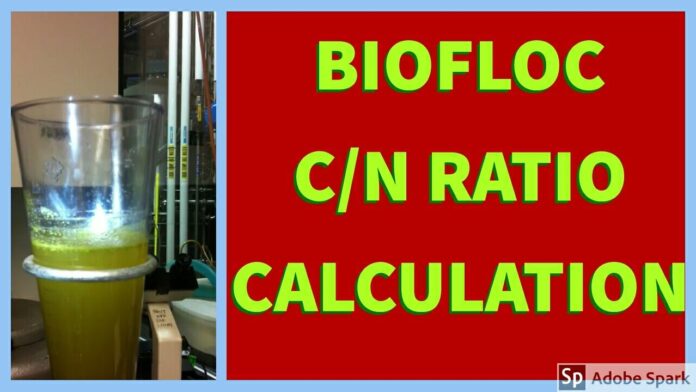CALCULATION OF CARBON: NITROGEN (C:N) RATIO IN BIOFLOC AQUACULTURE FOR BETTER FISH PRODUCTION
Praveen Srivastava, CEO, LBCS
BIOFLOC AQUACULTURE FOR BETTER FISH PRODUCTION
Carbon:nitrogen (C:N) ratio and its application
The management of the carbon-to-nitrogen ratio (C:N) in BFT is normally divided in two
phases:
(i) initial and formation phase, utilizing a carbon-to-nitrogen ratio of 12–20:1, and
(ii) maintenance phase, utilizing a carbon-to-nitrogen ratio of 6:1, according to the total ammonia nitrogen (TAN) values.
In the beginning of culture period, high carbon-to-nitrogen ratio (12–20:1) in water is a key factor to promote and stabilize the heterotrophic community in BFT . High carbon concentration will induce the nitrogenous by-product assimilation by heterotrophic bacteria and also will supersede the carbon assimilatory capacity of algae, contributing to bacteria growth.
Aerobic microorganisms are efficient in converting feed to new cell material (40–60% of conversion efficiency), rather than higher organisms (e.g., micro-herbivores, micro-carnivores, and deposit feeders) that spend about 10–15% to rise in weight. The system is considered “mature” (~30 to 50 days) when SS reaches at least 5 mL/L (measured using Imhoff cones) and TAN and nitrite peaks already occurred. To accelerate the water “maturation” (biofloc equilibrium), an inoculum of a previous BFT culture can be used once sanitary conditions are satisfactory.
It is important to note that as long as the production cycles advance, nitrifying (chemoautotrophic) bacteria play a major role in N-compound control. In addition, suspended particles or solids (bioflocs) also will be increasing over time. With this information in mind, carbon addition could be reduced (or even stopped), preventing the excess of solids (bioflocs) in the cultured system that will lead an excessive DO consumption and shrimp/fish gill occlusions.
For the maintenance phase, the monitoring of TAN values is an important tool for water
quality maintenance. When values of TAN are higher than 1.0 mg L−1, external carbon source application is recommended with a C:N ratio of 6:1. In such phase, the use of monosaccharide and oligosaccharide carbohydrate-rich types (e.g., molasses and other sugars) is recommended due to the faster bacteria assimilation and consequently TAN reduction.
Some examples of C:N calculations for the phase I and phase II are presented as followed. For both examples, the carbon content of the feed will be considered 50% (based on dry matter). For the carbon source, molasses was chosen and its content in such case is also 50%. It is important to note that the carbon content will change according to the dry matter composition and type of carbon source. In a practical way, dry matter of the feed will be 90%. Fish and shrimp assimilation will be considered 35 and 20%, respectively.
Example 1 (initial and formation phase using a C:N ratio of 20:1) in a tilapia culture tank
that receives 4 kg of feed (30% of crude protein) per day.
Calculation 1 (C:N content in the feed)
C: 4 kg of feed × 0.9 (90% dry matter) × 0.7 (30% of fish assimilation or 70% of waste that remains in water)/2 (carbon content of the feed is ~50% based on dry matter) = 1260 g of C N: 4 kg of feed × 0.9 (90% dry matter) × 0.7 (30% of fish assimilation or 70% of waste that remains in water) × 0.3 (30% crude protein content of feed)/6.25 (constant) = 121 g of N. The results indicated a ~10:1 C:N ratio of feed.
Calculation 2 (adjusting the C:N ratio)
If I want a C:N ratio of 20:1, 121 g of N in feed × 20 = I need 2420 g of C. But I already have 1260 g of C (calculated in feed). So 2420 g–1260 g of C = I really need 1160 g of C.
If the molasses has 50% of carbon content (based on dry matter), 1 kg of molasses represents 500 g of carbon. So, 1160 g of carbon requirement will represent 2320 g (or 2.3 kg) of molasses (applied daily until biofloc maturation ).
Example 2 (maintenance phase and C:N ratio of 6:1) in a L. vannamei culture tank (30 m3) that indicates 2.0 mg L−1 TAN values.
Calculation 1 (TAN in water)
For 2.0 mg L−1 of TAN in a 30 m3 tank = 0.002 g × 30,000 L = 60 g of TAN
Calculation 2 (adjusting the C:N ratio)100 Water Quality
If I want a C:N ratio of 6:1, 60 g of TAN in water × 6 = I need 360 g of C. If my molasses has 50% of carbon content (based on dry matter), 1 kg of molasses represents 500 g of carbon. So, 360 g of carbon requirement will represent 720 g (or 0.72 kg) of molasses (one application and checked after 2–3 days).



